Later, the Ayacucho archaeologist Luis G. Lumbreras, a student of the cultural developments of the Altiplano, carried out important investigations that allowed demonstrate that expansive development of great proportions (Middle Horizon) and of synthesis of diverse cultures, whose central nucleus was located between Huamanga and Huanta in Ayacucho, in the town of Wari near the Condorcunca hill. According to these investigations, the Wari cultural complex (Ayacucho) developed in three historical periods:1. Formation (6th and 7th centuries AD): Cultural synthesis on the Ayacucho base of Ñawinpukio, administrative center of the Huarpas.2. Apogee (7th – 10th centuries AD): Administrative centers of regions such as Viñake (capital), Atarco, Qosqopa, Pachacamac, etc.
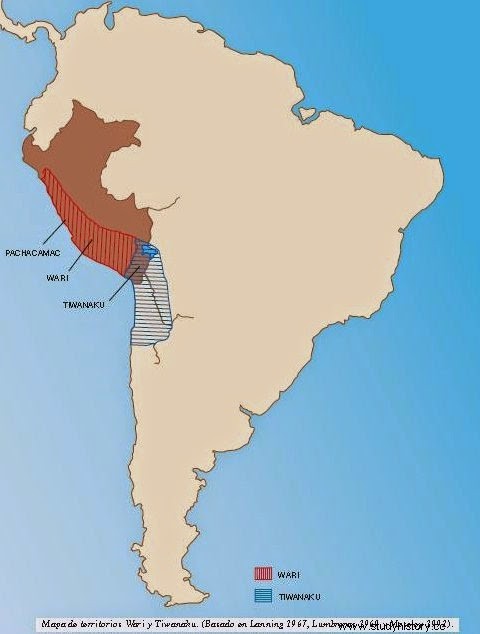 Expansion of the Wari Empire - Tiahuanaco 3. Declension (10th-11th centuries AD): Political decomposition of the great centers of decision (administrative cities):loss of control of the administered regions and invasions of Yaros and Chankas to Ayacucho.
Expansion of the Wari Empire - Tiahuanaco 3. Declension (10th-11th centuries AD): Political decomposition of the great centers of decision (administrative cities):loss of control of the administered regions and invasions of Yaros and Chankas to Ayacucho.FORMATION OF THE FIRST WARI ANDEAN EMPIRE
The Wari cultural complex, whose military expansion and control of a vast territory, requires us to speak of a Middle Horizon (between Chavín and the Inca Empire), which was inextricably linked with the colonial development of Tiahuanaco and the Nazca influence .The synthesis that originated the Wari culture brought together three fundamental units.1. Tiwanaku. It developed from the Peruvian-Bolivian Altiplano2. born. Regional culture that developed urban planning (cities such as Kiwachi, Tinguiña, etc), hydraulics and the most advanced pictographic ceramics of ancient Peru.3. Huarpas. Ayacucho Andean culture, which gains importance for being the synthesizing nucleus of the Wari imperial development that receives the influence of the aforementioned cultures.
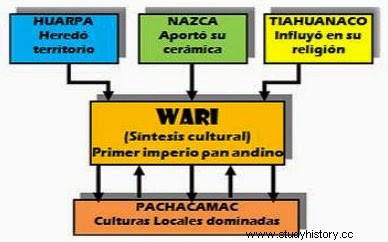 Wari - Cultural Synthesis The Huarpas developed in the year 400 of our era in the Ayacucho region, between the Apurimac and Pampas rivers, near which several organized settlements were established in small villages. Ñawinpuquio, its capital, stands out. However, around the year 500, an agricultural crisis must have occurred due to various factors, for example, droughts; Nazca military incursions from the coast, as well as the establishment of Tiahuanaco "enclaves". degree in coastal agriculture. As their economies weaken, the coastal regional developments seek diffusion towards the highlands:from Ilea to Ayacucho, coming into conflict with the expansive developments of the mountains; generating, then, the process of cultural synthesis that resulted in the first Andean militaristic empire:Wari. Later, other technological, administrative, ceremonial and craft elements of great importance were incorporated into the Wari synthesis from:* Pachacamac, in Lima and the entire yunga region.* Markahuamachuco, between Cajamarca and La Libertad, etc.
Wari - Cultural Synthesis The Huarpas developed in the year 400 of our era in the Ayacucho region, between the Apurimac and Pampas rivers, near which several organized settlements were established in small villages. Ñawinpuquio, its capital, stands out. However, around the year 500, an agricultural crisis must have occurred due to various factors, for example, droughts; Nazca military incursions from the coast, as well as the establishment of Tiahuanaco "enclaves". degree in coastal agriculture. As their economies weaken, the coastal regional developments seek diffusion towards the highlands:from Ilea to Ayacucho, coming into conflict with the expansive developments of the mountains; generating, then, the process of cultural synthesis that resulted in the first Andean militaristic empire:Wari. Later, other technological, administrative, ceremonial and craft elements of great importance were incorporated into the Wari synthesis from:* Pachacamac, in Lima and the entire yunga region.* Markahuamachuco, between Cajamarca and La Libertad, etc.The interaction of all these factors and others, still under study, determined the formation of this empire.
THE EXPANSION AND RISE OF THE WARI EMPIRE The economic situation of agricultural crisis and political chaos prevailing in the Andean area were the determining factors for the imperialist military solution, as well as the idea of concentrating the productive surplus of the subjugated peoples in an urban nucleus such as Viñaque in Ayacucho. The Wari expansion adopted, as the main mechanism, to manage and control the economy of the imperial territories, the construction of large urban centers duly planned, according to certain models or patterns of settlement whose size, population and peripheral area of control was in relation to the importance political and economic for the empire. In summary, the Wari empire designed a political structure of imperial expansion, using urban planning, to guarantee the economy of the army and control the economy of the population of the various regions under its administration.
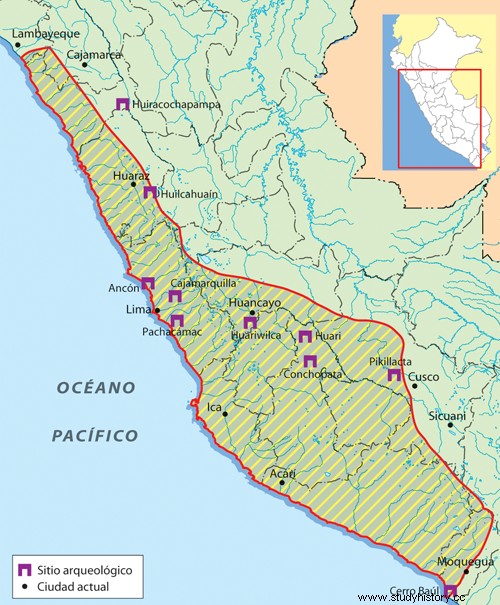 Wari Empire expansion map THE EXPANSION AND RISE OF THE WARI EMPIRE The economic situation of agricultural crisis and political chaos prevailing in the Andean area were the determining factors for the imperialist military solution, as well as the idea of concentrating the productive surplus of the subjugated peoples in an urban nucleus such as Viñaque in Ayacucho. The Wari expansion adopted, as the main mechanism, to manage and control the economy of the imperial territories, the construction of large urban centers duly planned, according to certain models or patterns of settlement whose size, population and peripheral area of control was in relation to the importance political and economic for the empire. In summary, the Wari empire designed a political structure of imperial expansion, using urban planning, to guarantee the economy of the army and control the economy of the population of the various regions under its administration. The empire is the form of a multinational state, where exploitation is not only "vertical", but "horizontal", causing taxes to be concentrated in a single territory and within it, in a social class that controls the can. The "imperial class" must be "rich" because it must have a sufficient amount of production reserves to maintain a stable and very powerful army, capable of imposing itself on many territories. All these requirements were met by the Wari culture. Hence its imperial character. . . whose main livelihood was the army. The conquest of new territories and inhabitants and the extension of their domains to various peoples and nationalities, as well as their consequent exploitation through military mechanisms, gave this new State such an imperial character (Toledo - 1989). In each imperial region there was a city or head of the region that coordinated planning with the main center of political decisions (Viñaque or Wari). They did so through a network of roads and probably using quipus for accounting and chasquis for communications.
Wari Empire expansion map THE EXPANSION AND RISE OF THE WARI EMPIRE The economic situation of agricultural crisis and political chaos prevailing in the Andean area were the determining factors for the imperialist military solution, as well as the idea of concentrating the productive surplus of the subjugated peoples in an urban nucleus such as Viñaque in Ayacucho. The Wari expansion adopted, as the main mechanism, to manage and control the economy of the imperial territories, the construction of large urban centers duly planned, according to certain models or patterns of settlement whose size, population and peripheral area of control was in relation to the importance political and economic for the empire. In summary, the Wari empire designed a political structure of imperial expansion, using urban planning, to guarantee the economy of the army and control the economy of the population of the various regions under its administration. The empire is the form of a multinational state, where exploitation is not only "vertical", but "horizontal", causing taxes to be concentrated in a single territory and within it, in a social class that controls the can. The "imperial class" must be "rich" because it must have a sufficient amount of production reserves to maintain a stable and very powerful army, capable of imposing itself on many territories. All these requirements were met by the Wari culture. Hence its imperial character. . . whose main livelihood was the army. The conquest of new territories and inhabitants and the extension of their domains to various peoples and nationalities, as well as their consequent exploitation through military mechanisms, gave this new State such an imperial character (Toledo - 1989). In each imperial region there was a city or head of the region that coordinated planning with the main center of political decisions (Viñaque or Wari). They did so through a network of roads and probably using quipus for accounting and chasquis for communications.Among the main cities head of the region we must mention:
• Huairacochapampa (Huamachuco, La Libertad)
• Pachacamac (Lima)
• Wilcahuain (Ancash)
• Cajamarquilla (Lima)
• Warivilca (Junín)
• Socus (Ica)
• Qosqopa (Arequipa)
• Pikillakta (Cusco)
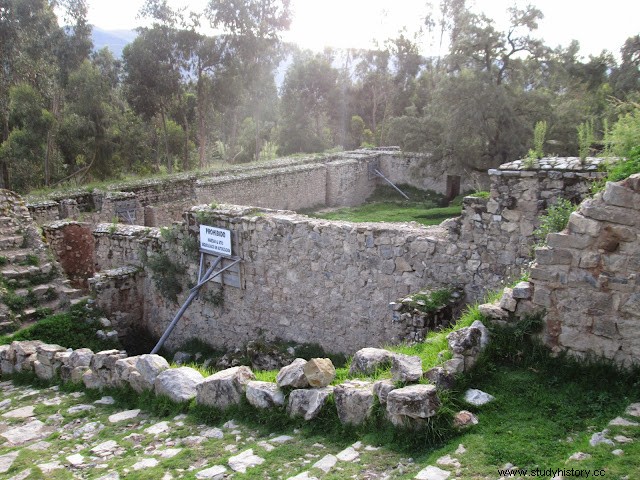 ARCHEOLOGICAL SITES This is how the city of Wari, 10 km from today's Ayacucho, became the first large city to be formed in South America and became the center of an imperial regional unit that subdued regions, indigenous curacazgos and peasants. These towns generate a surplus product, the result of collective surplus labor that the military lords, priests and officials take over:(idle and oppressive classes). The urban population of this empire dedicated itself to liturgical goldsmithing, work with precious stones, such as turquoise, polychrome and ceremonial pottery, and intense trade with the regional capitals, settled in distant subjugated regions. So, in addition to Wari, the central city had other smaller cities that had to provide labor and production to support the rulers of Viñaque.
ARCHEOLOGICAL SITES This is how the city of Wari, 10 km from today's Ayacucho, became the first large city to be formed in South America and became the center of an imperial regional unit that subdued regions, indigenous curacazgos and peasants. These towns generate a surplus product, the result of collective surplus labor that the military lords, priests and officials take over:(idle and oppressive classes). The urban population of this empire dedicated itself to liturgical goldsmithing, work with precious stones, such as turquoise, polychrome and ceremonial pottery, and intense trade with the regional capitals, settled in distant subjugated regions. So, in addition to Wari, the central city had other smaller cities that had to provide labor and production to support the rulers of Viñaque. WARIVILCA CITY -JUNÍN In the first place, the Wari also used mechanisms of ideological control in the conquered regions with the spread of the religious cult of the god Wiracocha or "astronomer-farmer deity", attributing immense powers to him over agricultural activity (this was done in order to legitimize the taxation of the surplus in favor of the State). Second, they used Quechua as a common language, proposing its generalized use in the Andes, which was only consolidated later with the Incas.
WARIVILCA CITY -JUNÍN In the first place, the Wari also used mechanisms of ideological control in the conquered regions with the spread of the religious cult of the god Wiracocha or "astronomer-farmer deity", attributing immense powers to him over agricultural activity (this was done in order to legitimize the taxation of the surplus in favor of the State). Second, they used Quechua as a common language, proposing its generalized use in the Andes, which was only consolidated later with the Incas.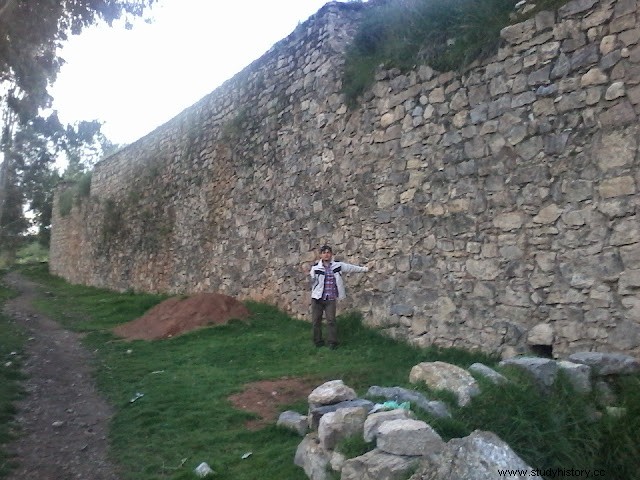 WALLS OVER 15 METERS HIGH AN ECONOMY IN TRANSFORMATION The economic base continued to be agriculture and livestock in the high punas; but there is a tendency of the State to reorient its livestock activities that allowed it to favor agriculture, since it prioritized certain crops and irrigation technologies were developed to expand its agricultural frontier. Many shepherds were turned into frogs or serfs, who had to work compulsorily. This generated a marked resentment in the high cattle punas that was surely exploited by the Collas and other enemies of the Wari empire. It is also necessary to highlight the flourishing of interregional trade in this first Andean empire (called the Middle Horizon), through the katus or fairs that developed around the urban centers. The exchange of products practiced during the Early Intermediate (Nazca, Mochica, Tiahuanaco and others) came to be controlled by the Wari State, for the benefit of the military theocratic caste and the imperial bureaucracy. During the expansion and apogee of the Wari Empire, parallel to the cultural homogenization that they imposed, economic guidelines were established that responded to the following factors:
WALLS OVER 15 METERS HIGH AN ECONOMY IN TRANSFORMATION The economic base continued to be agriculture and livestock in the high punas; but there is a tendency of the State to reorient its livestock activities that allowed it to favor agriculture, since it prioritized certain crops and irrigation technologies were developed to expand its agricultural frontier. Many shepherds were turned into frogs or serfs, who had to work compulsorily. This generated a marked resentment in the high cattle punas that was surely exploited by the Collas and other enemies of the Wari empire. It is also necessary to highlight the flourishing of interregional trade in this first Andean empire (called the Middle Horizon), through the katus or fairs that developed around the urban centers. The exchange of products practiced during the Early Intermediate (Nazca, Mochica, Tiahuanaco and others) came to be controlled by the Wari State, for the benefit of the military theocratic caste and the imperial bureaucracy. During the expansion and apogee of the Wari Empire, parallel to the cultural homogenization that they imposed, economic guidelines were established that responded to the following factors: Population increase.
Concentration of the population in cities like Viñake , of more or less 20,000 inhabitants with 10 hectares built and 2,000 hectares of agricultural production. The high level of technological development achieved made it possible to achieve a high production, both agricultural and artisanal; but before the advance of urban and demographic growth, they planned the development that established the regional capitals, as administrative centers. The structuring of imperial power in the Andes gave fluidity to trade and security to the participants of the katus or fairs from the high provinces.
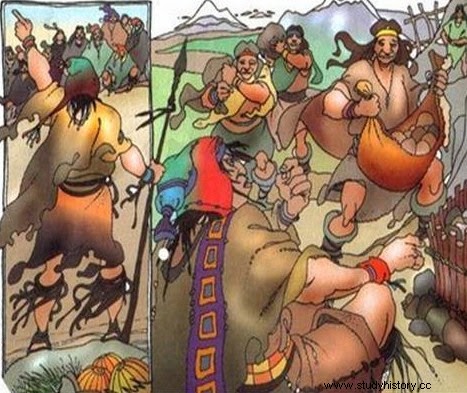
Given the Wari planning structure for managing resources in times of crisis - as noted above -Social relations of production were quite vertical and with marked class differences. The urban imperial pattern or model, both in the Ayacucho nucleus and in the subordinate regions, reveals deep social differences, as evidenced in the following facts:a. 10% of the city, in the downtown area, was devoted to temples and three-story palaces, with a central avenue (Capillayoq, Ushpaqoto, Chejowasi areas) and built in exceptionally carved stone (ashlar and lime), with walls decorated in red and white and equipped with underground galleries with burials of bodies with their throats cut. A powerful military base with ceremonial functions and of Ayacucho origin occupied this privileged sector. b. 30% of the capital city was made up of subordinate officials, dedicated to the administration of the exchange and the concentration of tax surpluses; also among them were soldiers of lesser rank. c. 10% allocated to squares, platforms, corridors, canchones, ducts and channels. d. 50% of the city area was occupied by artisans, who lived in rustic stone and mud constructions, a material similar to that used in the construction of the wall that surrounded the entire city. Areas must also have been allocated in these sectors for the residence of frogs or serfs.
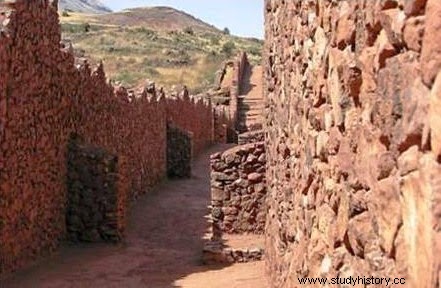 WARI STREETS AND ROADS But the majority base of the Wari social pyramid was made up of the agricultural producers of the subjugated ayllus. The productive surplus was in part taxed to the imperial state and in part exchanged among its own regional ruling class in the katus, under the supervision and profit of the imperial authorities. Such authorities, over time and in contact with foreign regional communities, promoted production under their own control and gradually generated the political and economic decomposition of the empire.
WARI STREETS AND ROADS But the majority base of the Wari social pyramid was made up of the agricultural producers of the subjugated ayllus. The productive surplus was in part taxed to the imperial state and in part exchanged among its own regional ruling class in the katus, under the supervision and profit of the imperial authorities. Such authorities, over time and in contact with foreign regional communities, promoted production under their own control and gradually generated the political and economic decomposition of the empire.WARI ARTISAN DEVELOPMENT
CERAMIC AS A DOCUMENT OF WARI PROGRESSIVE SYNTHESIS Ceramics are an extraordinary witness and silent element that documents the process of cultural synthesis reached by the Wari Empire. In the geographical area of Ayacucho (Ñawinpuquio), place of origin or paqarina of the imperial complex, different pottery styles made by a large labor force, which during the height of the empire produced more than sufficient quantities.
1. Early Huarpa style. Paintings in black or red on matte white, and with geometric decorations.2. Ceramics Chakipampa, Okros and Cruzpata. Of clear Nazca influence in urns and pitchers; where anthropomorphic motifs with monkey, feline and octopus features are observed. Violaceous red lines are predominant.
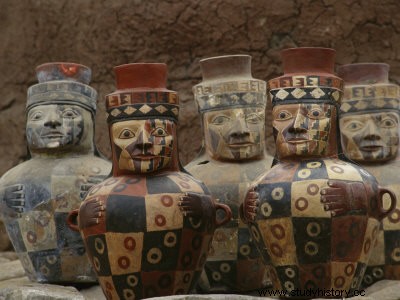
3. Conchopata ceramics. Its Huamanguino origin leads us to Caja pottery, orange in color, but only in its form of urns and cauldrons or incense pots (to produce smoke in ceremonies). For the first time, the image of the "god with the canes" is appreciated, also present on the Cover of the Sun of Tiahuanaco. This Tiahuanaco influence in the Conchopata pitchers reveals the beginnings of the Wari imperial development:the synthesis of Huarpa, Nazca and the Tiahuanaco culture.
4. Robles Moqo ceramics. It constitutes the classic style of imperial expansive development. Its practice began in the Wari cities, between the years 560 and 600 of our era, extending to Arequipa, the Santa River and Huaylas; but, it is in Ica where its best finish, brightness and polishing can be appreciated.

Both in the heyday and in the decadent phase (Pacheco, Socos, etc) they made gigantic pitchers in which they represented the "astronomer god" of Tiahuanaco. This divinity, due to the style it presents, has been called by some scholars as the "cross-eyed god"; but the truth is that his eyes represent the lunar phases:one of them the first quarter and the other the last quarter; which give the appearance of looking to the sides.
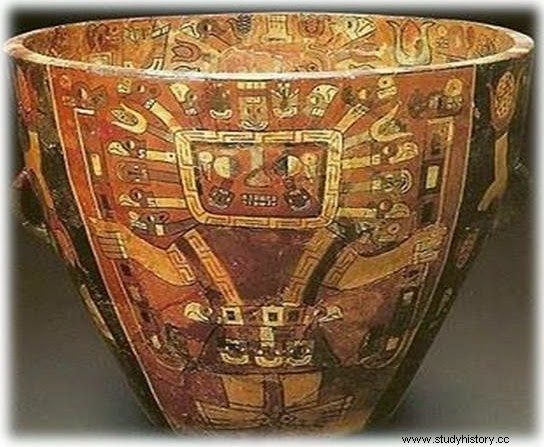 REPRESENTATION OF THE WARI GOD Although some authors link the Cover of the Sun with an agricultural calendar, in the case of the "cross-eyed god" of Wari, the astronomical intention and the link with agriculture are clear, especially with the tarwi (food) crisis. For this reason, the evocation and adoration, prior tribute, to the "astronomer farmer god", which must have meant in his followers the idea of a good harvest. The head decorated with agricultural products, signifies the start of corn and potato cultivation at a certain time of the year.
REPRESENTATION OF THE WARI GOD Although some authors link the Cover of the Sun with an agricultural calendar, in the case of the "cross-eyed god" of Wari, the astronomical intention and the link with agriculture are clear, especially with the tarwi (food) crisis. For this reason, the evocation and adoration, prior tribute, to the "astronomer farmer god", which must have meant in his followers the idea of a good harvest. The head decorated with agricultural products, signifies the start of corn and potato cultivation at a certain time of the year.In addition, the artisans of the empire also made textiles with a clear Tiahuanaco influence:"accordion" tapestries (compressed forms ) in cotton and wool, which represented mythological stylizations with pumas and condors. They also created shirts with polychrome decoration. They also worked with wood inlaid with precious stones (lapis lazuli and turquoise) and developed monolithic sculptures, with characters from their own political and religious organization.
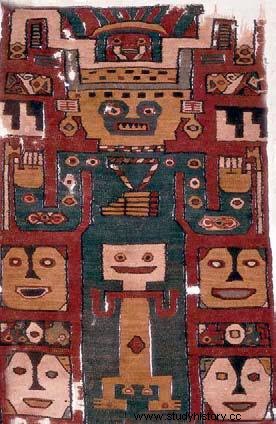 wari tapestry, one of the technical and aesthetic achievements in the Middle Horizon.
wari tapestry, one of the technical and aesthetic achievements in the Middle Horizon. services, technology and advice that allowed them to obtain an abundant harvest and manufacture of handicrafts... The migratory waves from the countryside to the city were increasing, the cities grew, but agricultural production declined. , according to some versions, another of a natural nature, that is, a severe drought in the Andean region" (Vargas Salgado - 1987).
THE END OF AN EMPIRE
INTERNAL CAUSES
There is no empire that lasts a long time. Just as it was formed through wars, the Wari Empire also ended up being attacked by the subjugated peoples.
The reasons were:
• Abandonment of the cities due to internal struggles between the local military aristocracy and the central one, which generated attacks, isolation and confusion.
• Loss of central control of the colonies due to regional rebellions against the empire, especially of the ranchers neglected by imperial policy.
EXTERNAL CAUSES
• Emergence of new developing towns (of a regional nature) that were able to face problems more effectively, in relation to the previous one with imperial centralized planning.
• Invasions of foreign towns, such as the rare or llacuaces and the chankas' that devastated the central nucleus (Viñaque) of the empire, in Ayacucho.
These causes converged and determined the collapse of the imperial Wari State, and gave way to the Late Intermediate or Second Regional Development.
>
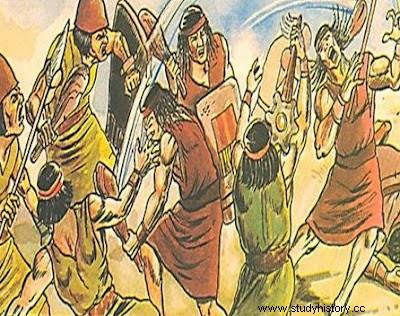 The internal wars between the military aristocracy "But in Ayacucho, with the development of the city of Wari and its incentives to attract the peasants, there was a gradual abandonment of the countryside and an urban overpopulation that led to regional impoverishment. Ayacucho, deprived of sufficient food resources It had to resort more and more strongly to the exchange of its handicrafts with products from the field. It seems that the Mantaro and Pampas valleys, its neighbors, were soon a source of resources and its old relations with Ica and Nazca were maintained favorably. But those were urban development zones that, in turn, required surplus peasant production, for which, in search of food, war became necessary". (Lumbreras 1974)
The internal wars between the military aristocracy "But in Ayacucho, with the development of the city of Wari and its incentives to attract the peasants, there was a gradual abandonment of the countryside and an urban overpopulation that led to regional impoverishment. Ayacucho, deprived of sufficient food resources It had to resort more and more strongly to the exchange of its handicrafts with products from the field. It seems that the Mantaro and Pampas valleys, its neighbors, were soon a source of resources and its old relations with Ica and Nazca were maintained favorably. But those were urban development zones that, in turn, required surplus peasant production, for which, in search of food, war became necessary". (Lumbreras 1974) 